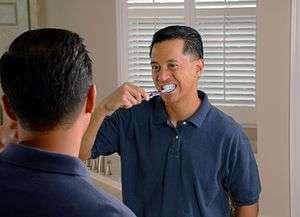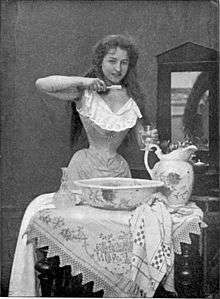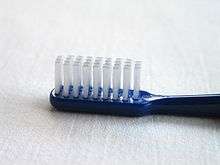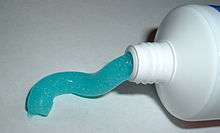Tooth brushing
Tooth brushing is the act of scrubbing teeth with a toothbrush equipped with toothpaste. Interdental cleaning (with floss or an interdental brush) can be useful with tooth brushing, and together these two activities are the primary means of cleaning teeth, one of the main aspects of oral hygiene.

Brushing teeth properly helps prevent cavities, and periodontal, or gum disease, which causes at least one-third of adult tooth loss.[1] If teeth are not brushed correctly and frequently, it could lead to the calcification of saliva minerals, forming tartar. Tartar hardens (then referred to as 'calculus') if not removed every 24 hours. Poor dental health has been associated with heart disease and shortened life expectancy.[2][3][4]
History

As long ago as 3000 B.C., the ancient Egyptians constructed crude toothbrushes from twigs and leaves to clean their teeth. Similarly, other cultures such as the Greeks, Romans, Arabs and Indians cleaned their teeth with twigs. Some would fray one end of the twig so that it could penetrate between the teeth more effectively.
Modern day toothbrushing as a regular habit became prevalent in Europe from the end of the 17th century. The first mass-produced toothbrush was developed in England in 1780. In the United States, although toothbrushes were available at the end of the 19th century, the practice did not become widespread until after the Second World War, when US soldiers continued the toothbrushing that had been required during their military service.[5]. The modern toothbrush was developed in England in 1780. While languishing in jail, William Addis decided to drill holes into a sheep's tibia, and pulled through the bristles of boar hair.
Toothbrushing guidelines
Frequency
Although there is a consensus that a thorough toothbrushing once a day is sufficient for maintaining oral health, most dentists recommend patients brush twice a day since a sufficient level of thoroughness in brushing is not normally achieved.[6]
Proper technique
The front and backs of teeth should be brushed with the toothbrush at a 45 degree angle towards the gum line, moving the brush in a back and forth rolling motion that makes contact with the gum line and tooth.[7] To brush the backs of the front teeth the brush should be held vertically to the tooth and moved in an up and down motion.[7] The chewing surfaces of the teeth are brushed with a forward and back motion, with the toothbrush pointing straight at the tooth.[7]
Timing
One study found that brushing immediately after an acidic meal (diet soda) caused more damage to enamel and the dentin, compared to waiting 30 minutes. Flushing the acid away with water or dissolved baking soda could help reduce acid damage exacerbated by brushing. The same response was recommended for acid re-flux and other acidic meals.[8]
Toothbrush

A toothbrush is an instrument used to clean teeth, consisting of a small brush on a handle. Toothpaste, often containing fluoride, is commonly added to a toothbrush to aid in cleaning. Toothbrushes come in manual and electric varieties. Although there is conflicting evidence as to which is more effective, most evidence points to electric toothbrushes with an oscillatory motion being more effective than manual toothbrushes, with toothbrushes lacking an oscillatory motion being equivalent.[9] A 2014 Cochrane review found moderate evidence that electric toothbrushing reduce plaque and gingivitis more than the manual one.[10] Overall, both manual and electric toothbrushes are effective, however, and it is often recommended that people use whichever one they feel comfortable with, determine what is affordable for them and will be more likely to regularly brush with.[11]
Toothbrushes are offered with varying textures of bristles, and come in many different forms and sizes. Most dentists recommend using a toothbrush labelled "soft", since firmer bristled toothbrushes can damage tooth enamel and irritate gums as indicated by the American Dental Association. Toothbrushes are often made from synthetic fibers, although natural toothbrushes are also known in many parts of the world. Those with dentures may also brush their teeth with traditional tooth brushes, specially made denture brushes or denture cleaners.
Toothpaste

Toothpaste is a paste or gel dentifrice used to clean and improve the aesthetic appearance and health of teeth. It is almost always used in conjunction with a toothbrush. Toothpaste use can promote good oral hygiene: it can aid in the removal of dental plaque and food from the teeth, it can aid in the elimination and/or masking of halitosis when tonsil stones are not the cause, and it can deliver active ingredients such as fluoride to prevent tooth and gum (gingiva) disease.
There is evidence that the addition of xylitol to fluoride-containing toothpastes reduces incidence of tooth decay by about 13%.[12]
Tooth powder
Tooth powder (or 'toothpaste powder') is an alternative to toothpaste. It may be recommended for people with sensitive teeth. Tooth powder typically does not contain the chemical sodium lauryl sulphate which can be a skin irritant.[13] The function of sodium lauryl sulphate is to form suds when teeth are brushed. It is a common chemical in toothpaste. Those with dentures may also use denture cleaner which can also come in powder format.
See also
References
- Fridus van der Weijden; Dagmar Else Slot (Nov 2, 2012). "The effectiveness of toothbrushing". Dental Tribune.
- Systemic Diseases Caused by Oral Infection Clinical Microbiology Reviews, October 2000, p. 547-558, Vol. 13, No. 4
- Osteoporosis and Periodontal Disease Division of Periodontology, Department of Dentistry, Taipei Veterans General Hospital, School of Dentistry, National Yang-Ming University, Taipei, Taiwan, R.O.C.
- Periodontal infections and cardiovascular disease Archived 2012-11-18 at the Wayback Machine JADA, Vol. 137. October 2006
- Mary Bellis. "History of the Toothbrush and Toothpaste". About.com Money.
- Attin, T.; Hornecker, E. (2005). "Tooth brushing and oral health: how frequently and when should tooth brushing be performed?". Oral Health Prev Dent. 3 (3): 135–140. PMID 16355646.
- "Proper Brushing" (PDF). American Dental Hygienists Association. Retrieved 30 June 2015.
- Anahad O'Connor (21 May 2012). "Really? Never Brush Your Teeth Immediately After a Meal".
- Robinson, PG.; Deacon, SA.; Deery, C.; Heanue, M.; Walmsley, AD.; Worthington, HV.; Glenny, AM.; Shaw, WC. (2005). "Manual versus powered toothbrushing for oral health". Cochrane Database Syst Rev (2): CD002281. doi:10.1002/14651858.cd002281.pub2. PMID 15846633.
- Yaacob, Munirah; Worthington, Helen V.; Deacon, Scott A.; Deery, Chris; Walmsley, A. Damien; Robinson, Peter G.; Glenny, Anne-Marie (2014-06-17). "The Cochrane Library". Cochrane Database of Systematic Reviews. doi:10.1002/14651858.cd002281.pub3. PMID 24934383.
- "Learn More About Toothbrushes". American Dental Association. Retrieved 1 July 2015.
- "Can xylitol used in products like sweets, candy, chewing gum and toothpaste help prevent tooth decay in children and adults?". Cochrane. 26 March 2015.
- "MATERIAL SAFETY DATA SHEET ON SODIUIM LAURYL SULFATE". healthy-communications.com.